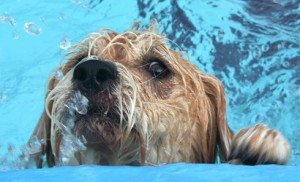Not all dogs are good swimmers. There are certain dogs that as soon as they see water they jump in, other dogs can be fearful of water. In the same manner that we are careful with children about pool safety, we should also be concerned about pool safety for our four legged friends.
If you have a pool at home here are some guidelines that the Association of Pet Dog Trainers suggests:
- Give your pup a gradual introduction into the pool. It is believed that by holding him tight to your body and walking into the water will make it a less traumatic experience than by just pushing the pup into the water. Give the pup praise and don’t be loud or have splashing sounds that may scare the animal. Make it a positive experience with lots of encouragement and praise.
- Teach proper swimming technique. All dogs will instinctively paddle when submerged in water, but as inexperienced swimmers, many dogs try to rely on their front legs and do little with their rear legs. This results in an almost vertical swim technique with lots of splashing. It’s exhausting and very easy for a dog to become over-tired this way. With proper training, the most vertical of swimmers can learn to use their rear legs, evening out their performance and swimming much more effectively and safely.
- Keep a close eye on your dog – if you see them become over-stimulated or fatigued, it is time to call them out. If you see your accomplished swimmer dog lowering his rear, this is a sign that he is getting tired.
- Dogs have poor depth perception so if the pool has steps, mark them with a big potted plant and make sure he associates the plant as the exit marker. If there are no steps, provide a non-slip ramp for getting out. Spend sufficient time training him to go up the ramp if he’s alone.
- Keep safety floatation devices nearby, just in the case of an emergency. If your dog gets into trouble, a life preserver attached to a long line is the best course of action to take. Dogs panic easily in the water when trouble hits, and a panicked, flailing dog can accidentally drown any person trying to assist it. Get the dog to grab out to the preserver first and try to reel it in closer to shore before physically trying to help it out.
- Training polite pool manners is a must. A big Golden Retriever sailing through the air in her excitement to get in the water is a no-no. Train the canine to “Wait” at pool’s edge or to always use the steps or the ramp.
- Teach the pup that the “Come” command applies to the pool as much as it does to dry land.
- Be mindful of the specific needs of your dog’s breed. Each dog’s physical structure and body-type will greatly impact his swimming ability. Heavily muscled bully breeds exert more energy while swimming due to their increased body mass. Consider using a lifejacket with such dogs for added protection.
- Watch your dog’s nails! Dogs can quickly wear their nails down to the point of bleeding as they excitedly race around the pool’s exterior. Keep a watchful eye on the pads of their feet as well. Repeated launching from pool steps can tear up paw pads; especially for dogs who spend most of their time on grass.
- Unless your pool cover is solid and strong enough to support your weight, do not leave it on when your dog is unattended near the pool. Countless dogs, even accomplished swimmers, have lost their lives following an unexpected tumble into a covered pool. Once they’re in, the cover is disorienting and it’s almost always impossible for a dog to find his way out. If your dog needs to spend time in the yard unsupervised, consider erecting a pool safety fence.
- Avoid letting your dog drink pool water. Always keep an ample supply of fresh water around so your dog can drink without attempting to drink from the pool. Also make sure you give your dog many opportunities to relieve himself after a swim as he is likely to ingest water from wherever he is swimming (pool, pond, lake or ocean) and may need to urinate more often.
- Make sure you rinse your dog off after a swim to get chlorine and other pool chemicals.
- Don’t let your dog sit in a wet collar as hot spots can develop. Be mindful of areas where water can collect, like ears, groin, and armpits, where moisture-induced infections can occur.
- If your dog is overweight or a senior, check with your veterinarian first before allowing him to swim. This is also important for dogs that are generally sedentary. Dogs, like people, experience muscle soreness and stiffness and they’re counting on us to lookout for their best interests.
There are also great products that can help you keep your pup safe in case of an accident may occur while you are not paying attention. The Safety Turtle is a pet immersion alarm. According to the Safety Turtle page around 50,000 dogs die each year in backyard pools. Another popular buy are dog life jackets. Just like in a human life jacket, size matters and you need to know how big and heavy the dog is to get the right fit. Make sure you check the dog float weight guidelines are sufficient enough to support the dog when in the water. Pool docks and ramps are also available! These attachments provide an escape route for animals, including wild critters like frogs, squirrels and turtles that might wander into your swimming pool.
 Montreal Dog Blog Montreal's Online Dog Park
Montreal Dog Blog Montreal's Online Dog Park




